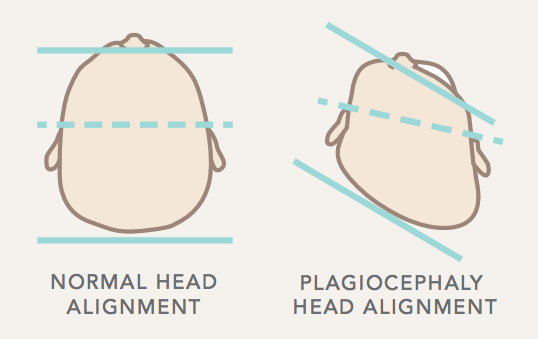PLAGIOCEPHALY
 Plagiocephaly or sometimes called flat head syndrome, is a condition where the head is asymmetrical and flattened on one side more than the other. Oftentimes the shape resembles a parallelogram with one side of the forehead pushed further out than the other and shifting in the jaw and ears. One eye may appear larger than the other. Often parents assume this is a cosmetic issue but this is not the primary concern. Shifting of the ears and jaws, when moderate or severe, is considered a risk factor for issues later in life with pain with chewing and speaking (TMJ). Visual issues do arise when the eyes are not in alignment.
Plagiocephaly or sometimes called flat head syndrome, is a condition where the head is asymmetrical and flattened on one side more than the other. Oftentimes the shape resembles a parallelogram with one side of the forehead pushed further out than the other and shifting in the jaw and ears. One eye may appear larger than the other. Often parents assume this is a cosmetic issue but this is not the primary concern. Shifting of the ears and jaws, when moderate or severe, is considered a risk factor for issues later in life with pain with chewing and speaking (TMJ). Visual issues do arise when the eyes are not in alignment.
Concerns with moderate to severe plagiocephaly:
- Misalignment of upper and lower jaw (cross bite)
- TMJ in late adolescence – clicking and/or pain with chewing and speaking
- Glasses fitting well and other visual issues
- Implications of facial asymmetry (one eye or cheek appearing larger than the other due to a shift in the underlying bone structure)
PLAGIOCEPHALY TREATMENT
Depending on age and severity there are different courses of plagiocephaly treatment. These range from specialized occupational or physical therapy; an individualized program of positioning and activities at home; and/or a cranial band. While we are highly skilled and have excellent results with the cranial band we utilize, we are devoted to limiting to their use to only those infants for whom other means have been exhausted. The infant is comfortable in the cranial band. It’s the time and cost that we try to avoid.
- A home program individualized for the particulars of each infant’s head and neck. This includes positioning and activities and exercises.
- Specialized therapy for cases of moderate to severe brachycephaly and/or torticollis. Varies from an average of 1 to 4 sessions. Torticollis issues may need therapy for a period of months.
- Neurodevelopmental techniques
- Myofascial release
- Craniosacral Therapy (CST)
- Kiniesiotaping
- Cranial band or orthotic treatment
Most babies find therapy sessions engaging and interesting and there is little crying. We’ve treated so many infants for so many years and have developed methods which are effective and comfortable for the baby and parent. We encourage you to try to schedule an appointment at a time when your baby is usually rested, fed, and happy.
ELIZABETH/MYERS PARK LOCATION
341 NORTH CASWELL ROAD
CHARLOTTE, NORTH CAROLINA 28204
(704) 379-7773
© 2023 Carolina Kinder Development
Devoted to infant development and prevention and treatment of torticollis, plagiocephaly and brachycephaly.
SOUTH CHARLOTTE LOCATION
7300 CARMEL EXECUTIVE PARK DRIVE
SUITE 125
CHARLOTTE, NC 28226
704-379-7773



